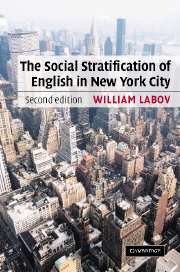Book contents
- Frontmatter
- Contents
- Introductory note
- Preface to the first edition
- Preface to the second edition: forty years later
- I Problems and methods of analysis
- 1 The study of language in its social context
- 2 First approach to the structure of New York City English
- 3 The social stratification of (r) in New York City department stores
- 4 The isolation of contextual styles
- 5 The linguistic interview
- 6 The survey of the Lower East Side
- II Social differentiation
- III Social evaluation
- IV Synthesis
- Glossary of linguistic symbols and terminology
- Appendix A Questionnaire for the ALS Survey
- Appendix B Anonymous observations of casual speech
- Appendix C Analysis of losses through moving of the MFY sample population
- Appendix D Analysis of the non-respondents: the television interview
- Appendix E The out-of-town speakers
- Bibliography
- Index
3 - The social stratification of (r) in New York City department stores
Published online by Cambridge University Press: 18 December 2009
- Frontmatter
- Contents
- Introductory note
- Preface to the first edition
- Preface to the second edition: forty years later
- I Problems and methods of analysis
- 1 The study of language in its social context
- 2 First approach to the structure of New York City English
- 3 The social stratification of (r) in New York City department stores
- 4 The isolation of contextual styles
- 5 The linguistic interview
- 6 The survey of the Lower East Side
- II Social differentiation
- III Social evaluation
- IV Synthesis
- Glossary of linguistic symbols and terminology
- Appendix A Questionnaire for the ALS Survey
- Appendix B Anonymous observations of casual speech
- Appendix C Analysis of losses through moving of the MFY sample population
- Appendix D Analysis of the non-respondents: the television interview
- Appendix E The out-of-town speakers
- Bibliography
- Index
Summary
[The department store study has received a great deal of attention, and many people have written to me for information about it who have no other knowledge of the New York City study. Of the year and a half spent studying New York City, a day and a half was spent in the three department stores. I have been concerned that people would not see past the method to the importance of the results. Yet the department store study has withstood the test of time. It has been replicated many times – twice in NYC department stores – with extraordinary fidelity, and it articulates with the larger study in remarkable detail, showing that the inquiry limited to the Lower East Side is valid for the city as a whole. It contributes to one of the most unexpected findings of this study: that the great metropolis is a geographic unity. Furthermore, rapid and anonymous studies have been established as an efficient and reliable tool of sociolinguistic research.]
So far in the investigation of the speech of New York City, we have been taking a very close view of the linguistic behavior of individuals. As a preliminary to extending this method to large numbers of speakers, it will be useful to consider a survey of the speech of New York City department store employees, conducted in the November of 1962. This survey was designed to test two ideas that arose from the exploratory interviews: first, that the variable (r) is a social differentiator in all levels of New York City speech; and second, that casual and anonymous speech events could be used as the basis for a systematic study of language.
- Type
- Chapter
- Information
- The Social Stratification of English in New York City , pp. 40 - 57Publisher: Cambridge University PressPrint publication year: 2006
- 2
- Cited by



